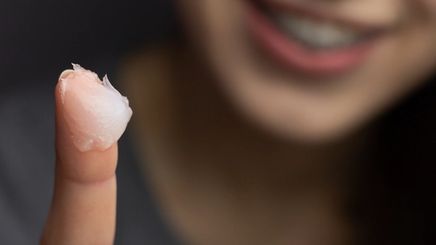
If slugging sounds like a sticky, slimy mess, it’s because it is. Originating from the world of , slugging is the practice of slathering petroleum jelly all over your face — for skincare benefits. Bet you didn’t see that coming? For what seems like forever, we’ve been told that petroleum jelly doesn’t belong on the face, only on rough areas like elbows, knees, and heels. Leave it to to bust that myth wide open on .
The Science Behind Slugging
Of all the known uses of Vaseline, slugging is a bit unorthodox. Slugging, inspired by the word “slug,” is coating your face with a thin layer of Vaseline Petroleum Jelly to create a physical barrier that prevents water loss. Specifically, this attempts to prevent transepidermal water loss, which is the amount of water that passively evaporates through the skin to the environment.
A 2014 report in the Journal of Applied Dermatotoxicology states that the average TEWL for humans is 300 to 400mL per day, depending on humidity. An increase in TEWL indicates impaired skin barrier function, which correlates to , according to author Toni Miller in the Skin Aging Handbook.
Atopic skin, or skin that’s prone to dryness-related flareups, has more TEWL and a reduced ability to hold moisture in. This type of skin is likely . So is it safe to use petroleum jelly for eczema treatment? Yes, with the right product and proper usage.
According to the Journal of Dermatological Science, the best therapy for this issue is . Further, it cites that the best way to strengthen the skin barrier function is to apply an occlusive moisturizer after cleansing the area to retain absorbed water.
Vaseline Petroleum Jelly is a popular occlusive (used in most slugging TikTok videos), which means it’s an impermeable material that prevents normal evaporation from the epidermis. The Journal of Indian Dermatology states that Vaseline prevents 98% of water loss from the outer layer of the skin. This makes Vaseline petroleum jelly suitable for eczema-prone skin.
How do you put Vaseline moisturizer on your face?
The idea behind slugging is putting an occlusive, like Vaseline, on your face to lock moisture in. There are two ways to do it. First, you do a mask. Clean your face with a hydrating cleanser. While your skin is still damp, apply a thin layer of petroleum jelly and leave it on for a few hours. Wash it off before and then do your usual evening .
The second way — and this is where it gets sticky — is to leave it on overnight. After washing your face, you can apply your usual skincare routine, but skip the spot treatments and any oils. Apply a thin layer of Vaseline all over your face and go to bed. You don’t need to look like an alien emerging from a cocoon to be slugging, so don’t overdo it. Most people can’t tolerate its stickiness, and yes, it will transfer all over your pillows, so choose your method wisely.
But Won’t It Clog the Pores?
There are conflicting studies on this matter. In a 1996 study in the Journal of the Society of Cosmetic Chemists, 10 acne patients applied petrolatum, previously reported to be , on their skin twice a day for eight weeks. The study found no evidence of comedogenic potential, and that greasiness cannot be assumed equal to comedogenicity.
Further, a 2016 review in the Journal of Allergy and Clinical Immunology states that there are no reports of severe allergic reactions to petroleum jelly. The study also found that it robustly increases barrier function.
On the other hand, the American Academy of Dermatology warns against using petroleum jelly on the face, especially on acne-prone skin. While it’s typically safe to apply it on dry areas of the body, slugging with petroleum jelly may not be for everyone. It can , especially if you start sweating or producing excessive oil under the occlusive layer.
To test, apply it on your lips overnight to see if it causes any new pimples. Or you could try doing the shorter version of slugging to see how your skin reacts.
Interested in slugging? Grab a tub of Vaseline Petroleum Jelly and smooth a small amount all over your face to improve your skin’s response to irritants and its ability to hold moisture. If you have acne-prone skin, consult your doctor before trying anything.